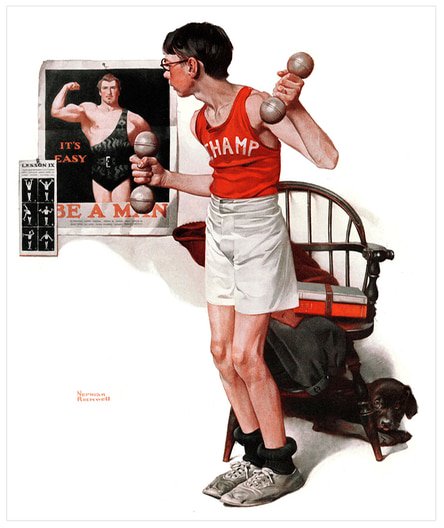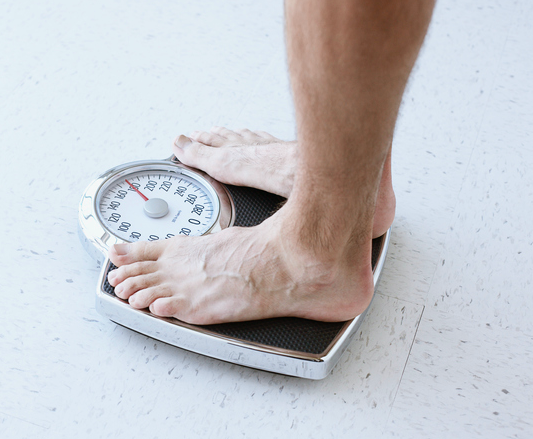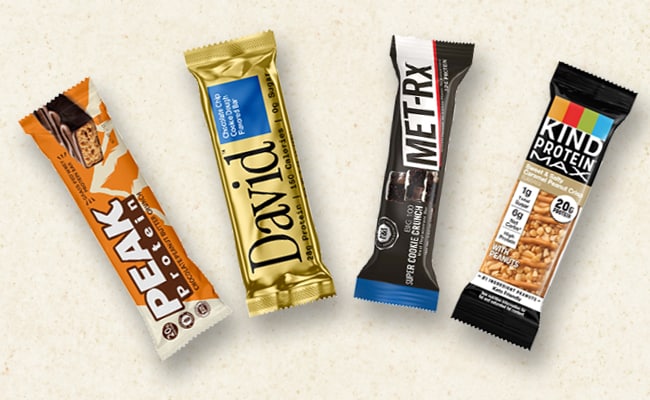Most articles and books out there about diet and nutrition focus on how to lose weight. It makes sense. When 70% of the U.S. population and 30% of the world population is overweight, that sort of information is going to be in demand.
But there are some folks out there — almost entirely males — who are looking to gain weight. This is the guy who’s the proverbial 90-pound weakling who’s had sand kicked in his face since he was a teenager. He’s tired of looking gangly and wants to fill out his frame a little more. But he can’t seem to gain any fat, much less muscle; no matter what he does or what he eats, it seems like he can’t put any meat on his bones.
Then there’s the guy who isn’t skinny, and doesn’t have trouble gaining weight — at least in terms of fat — but who’d like to put on some more muscle mass without turning into a blob in the process. He’s tried doing so in the past, but just ended up looking like the Stay Puft Marshmallow Man.
To figure out how both types of men — the “hard gainer” and the “easy gainer” — can put on more pounds of muscle mass without also putting on too much fat, I talked to my strength coach and the head of Barbell Logic Online Coaching. Matt Reynolds. Since starting to work with Matt two years ago, I’ve gained 40 pounds while taking two inches off my waist. Here’s how you can achieve similar results.
How to Gain Weight Summary
- Lift weights.
- Consume at least 1.1 grams x your weight in protein.
- Consume at least 2g per pound of bodyweight in carbs.
- Consume at least .5g per pound of bodyweight in fat.
You Need to Weight Train
Whether you’re a hard gainer or an easy gainer, if putting on muscle mass is your goal, you need to be actively engaged in strength training. The stress of weight training encourages testosterone and human growth hormone production, as well as kicks off protein synthesis. This cocktail of biological processes is what causes your body to create hard, heavy muscle instead of lumpy, soft fat.
If you’re not already, start a strength training program. We recommend Starting Strength because it’s simple and it works.
While training is an important element for gaining weight, your diet is even more important. Below we cover how a diet should look for both hard gainers and easy gainers who want to increase their muscle mass.
How to Gain Weight If You’re a “Hard Gainer”
You’re a “hard gainer” if you, well, have a hard time gaining weight. Genetics has blessed you with a super high metabolism. It seems like you can eat whatever you want and not put on any lbs. You were skinny as a kid, and you’re still skinny as a 30-year-old man.
Hard gainers tend to be younger — teens to late twenties (though many men who are skinny as young adults, stay skinny their whole lives through). That’s when metabolism is at its peak for most men due to increased testosterone levels, which only supercharges a hard gainer’s already unusually potent fat-burning system.
Jimmy Stewart is a perfect example of a hard gainer. The man desperately wanted to serve his country during WWII as a pilot, but he didn’t weigh enough. So he went on a diet of eating nothing but potatoes and malts for a few months to put on some weight. He still didn’t weigh enough at his physical examination. Instead of sticking him with a 4F classification, which would have forced Stewart to sit out the war, the doctor giving him the exam took pity on the scrawny young man, and let him pass. Stewart then went on to become a decorated bomber pilot in Europe.
If you’re a hard gainer, you’re going to have to eat a lot of food. You might think you’re eating a lot, but you’re probably not. I’ve had a few self-described hard gainers tell me what they eat during the day, and it’s just not that much. Yeah, they might wolf down a big dinner, but during the rest of the day, they eat like birds.
To ensure that you’re consuming enough calories to gain weight, download a nutrition tracker app, like MyFitnessPal. You need to get in the habit of tracking every single calorie that goes into your body; you need to aim to hit hard numbers, rather than relying on vague perceptions of “a lot.”
Now it’s time to set some macronutrient goals for yourself. There are three major macros you’ll be tracking: protein, carbs, and fat.
Protein. Protein is what your body uses to create new muscle tissue. A lot of hard gainers I’ve talked to don’t get enough of it.
A rough estimate of the amount of protein you need each day is 1.1 grams per pound of bodyweight. If you weigh 155 lbs, that means you’d need about 170.5 grams of protein a day (155 X 1.1).
For hard gainers, Matt actually recommends starting off with 200 grams of protein a day. In fact, he starts most of his male strength-training clients — no matter their weight — at 200g of protein a day. “Protein is the most important macronutrient for muscle building. We need to make sure we’re providing muscle cells with the branch chain amino acids they need to undergo protein synthesis after training,” he says. And no, you don’t need to worry about protein hurting your kidneys or liver or whatever. Unless you have some sort of kidney or liver disease, you’re not going to poison yourself from consuming that much protein. Dr. Jordan Feigenbaum goes into debunking this myth in the podcast I did with him last year.
With that said, Matt does think that no one should be consuming more than 250 grams of protein, as there’s no benefit after that amount. Even if that much protein won’t hurt your body, it’s going to put a squeeze on your wallet.
You can set your protein levels by bodyweight, but you’ll need to adjust things as you put on pounds. If you’d like just to set it and forget it, make it a goal to get at least 200 grams of protein a day.
Carbs. Carbs provide glycogen which fuels our muscles during anaerobic activity like barbell training. A rough estimate for the carbs you need a day to gain weight is 2g per pound of bodyweight. So if you’re 155lbs, you should be getting 310g of carbs a day.
But as mentioned above, if you’re a hard gainer, you can increase your number of carbs as needed. According to Matt, you can increase carbs up to 500g a day if you’re really looking to gain weight.
Fat. Fat is a vital macronutrient for our body. It’s also high in calories, which is great if you’re trying to gain weight. General recommendations for fat intake if you’re trying to gain weight is .5g per pound of bodyweight. So our 155lb male should be consuming a minimum of about 77g of fat a day.
But if you’re a hard gainer, increasing fat consumption is an easy way to create that caloric surplus you need to gain weight. So we should use that to our advantage by increasing fat consumption dramatically. Matt says for most hard gainers, shooting for 150 to 200g of fat a day would be ideal.
Bringing It All Together for the Hard Gainer
Let’s walk through a possible macro make-up for a 155lb male who’s a hard gainer.
Protein: We’ve decided to make it easy for him by setting his protein levels at 200g per day. There are 4 calories in every gram of protein, so that gives us 800 calories from protein (200 X 4). We’ll keep that there and use carbs and fat to reach his needed caloric surplus.
Carbs: We’ll start off with the minimum recommended amount of carbs to gain weight, which is 2g per pound of bodyweight. So our guy will be eating 310g a day (2g X 155lbs). There are 4 calories in a gram of carbs, so that’s 1,240 calories from carbs (310 X 4).
Fat: We’ll be a bit more aggressive with the fat and do 1g of fat per pound of bodyweight. So he’ll eat 155g of fat a day. There are 9 calories in a gram of fat, so that’s 1,395 calories from fat (155 X 9).
Total calories a day: 3,435
That’s a lot of food and probably more than what most hard gainers think they’re eating, even when they think they’re eating a lot. We’ll dig in here at the end on the type of food you should be eating to hit those macro goals (and no, it doesn’t mean you can eat a lot of junk).
According to Matt, hard gainers should aim to add 2-3lbs of bodyweight a week. Any more than 3lbs, and the weight increase will come primarily in the form of fat accumulation. If you’re gaining more than 3lbs a week, you’ll need to decrease calorie consumption.
If you’re gaining less than 2-3 pounds a week, you’ll need to increase your calorie consumption.
When you make adjustments to your macros, keep your protein intake the same; adjust the carbs and fat up or down as needed.
Matt recommends making adjustments of 100 calories per day per week. So for example, if our 155lb dude isn’t gaining weight consuming 3,435 calories a day, we’d bump that number up to 3,535 a day for a week. We’d do that by increasing his carbs and fat. For this guy, we could simply add 25g of carbs to his diet a day to get that 100-calorie increase. We’d see how that goes for a week. If he’s still not gaining weight, we’d add another 100 calories a day.
If you’re gaining too much weight, make the same 100 calorie adjustment, but in the downward direction. Decreasing fat is the quickest way to decrease total calories. In our example, reducing fat intake by 11g will reduce total calorie intake by 100.
Gaining weight, particularly weight that’s primarily muscle, isn’t an overnight affair. You’ll need to dedicate yourself to eating like a horse for the next six months before you start noticing significant changes in your physique.
How to Gain Weight If You’re an “Easy Gainer”
If you have no problem putting on the pounds, but you want to gain weight while not getting fat in the process, we’re going to do pretty much what the hard gainers do nutrition-wise, except take it easier on the fat intake.
Bringing it Together for the Easy Gainer
Let’s say you’re a 185lb male who wants to weigh 200lbs. We’d follow pretty much the same template as a hard gainer, but be less aggressive with the fat intake (.5g X bodyweight) since fat has a lot of calories in it. Let’s walk through a macro breakdown for this guy:
Protein: 200g per day
Carbs: 370g (2g x 185lbs)
Fat: ~92g (.5g x 185lbs)
Total calories: 3,112
Easy gainers should shoot to put on 1-1.5 pounds of bodyweight a week. If you’re gaining more than that, adjust calories down 100 a day by decreasing carb and fat intake. Start by reducing fat first since it’s the most calorically dense.
For what it’s worth, the macro breakdown above is pretty much what I used to go from 185lbs to 220lbs in about a year and a half, while still losing two inches around my waist. Matt adjusted things down every now and then when I was gaining too much weight too fast, but I’ve pretty much stayed at around the 3,000 calorie mark since working with him.
What to Eat to Gain Weight
If you’re trying to gain weight, you don’t get carte blanche to eat whatever crap you want. You want to eat “clean” and focus on single ingredient foods.
Protein Sources
- Whey protein. Whey protein is relatively cheap and makes hitting your protein goals each day easy. Assuming your protein goal is 200g a day, two shakes with 50g of protein each will get you halfway there. Get a whey isolate protein. It’s cheaper than other kinds out there and provides the BCAAs you need for protein synthesis.
- Chicken. Chicken breasts will become your friend. Buy a frozen bag of them and grill them up on the weekend so you can eat them for lunch during the rest of the week.
- Tuna. Cheap and portable. Great for lunches at work.
- Beef. If you’re a hard gainer, you can dig into fatty cuts like rib eye with gusto. If you’re an easy gainer, stick to lean cuts of beef like sirloin.
- Pork. Hard gainers can pig out (see what I did there?) on fatty pork cuts — sausage, bacon, pork butt. If you’re an easy gainer, stick to leaner cuts like pork chops.
- Eggs. Great source of both protein and fat. If you’re a hard gainer, eat lots of whole eggs; if you’re an easy gainer, consume less whole eggs and more egg whites for the lean protein.
Carb Sources
- Oatmeal. It’s cheap, easy to cook, and packed with fiber. Get the instant oats to make your life easy. It’s not just a breakfast food. You can eat this as part of a snack.
- Rice. Cheap and easy to cook. Use it as a staple at lunch and dinner.
- Potatoes. Regular or sweet potatoes are fine. I prefer sweet potatoes because of their taste.
- Fruits. Bananas and apples have lots of carbs and fiber in them, plus they’re portable and taste good.
- Veggies. While many veggies don’t have a lot of carbs in them per serving, you should consume as much of the green stuff as possible for the fiber and micronutrients.
- Breads. If you’re a hard gainer, feel free to eat bread to hit your carb macros for the day. If you’re an easy gainer, you don’t need to eliminate bread, but watch your portions; it’s easy to pig out on.
- Pasta. Similar to bread in its appropriateness for easy and hard gainers.
- Sweets. Both hard and easy gainers need to be judicious with sweets. You don’t need to eliminate them from your diet altogether, but if you’re trying to gain weight by simply eating donuts and Reese’s Peanut Butter Cups, you’re going to be putting on primarily fat. They should be eaten sparingly.
Fat Sources
- Healthy oils. Olive, avocado, and coconut oils.
- Nuts. Cashews, almonds, Brazil nuts, etc.
- Avocado/Guacamole. Yes, we know it costs extra, Chipotle worker. Still worth it.
- Whole eggs
- Whole milk. See “Should I GOMAD?” below.
- Butter (you can even put it in your coffee!)
- Fatty cuts of meat
Should I GOMAD?
If you’re familiar with Starting Strength, you’ve probably run across the acronym “GOMAD” before. It stands for “Gallon of Milk a Day,” as in drinking that amount of cow juice in a single day.
It’s an oft-misunderstood and misquoted nutrition recommendation from Starting Strength founder Mark Rippetoe.
Drinking a gallon of whole milk a day is an easy, quick, and cheap way to ensure you’re getting the calories you need to gain weight (~2400). Whole milk also has a great balance of protein, carbs, and fat (Protein: 126g; Carbs: 188g; Fat: 126g). If you were to GOMAD, you probably wouldn’t need to buy a whey protein supplement because you’ve got most of your protein in that gallon of milk.
As Rip has tried to clarify countless times, GOMAD is only directed towards skinny teenage boys or young 20-something men who have a hard time gaining weight due to a high metabolism. If you’re older than 30 or are already pretty hefty, you should NOT GOMAD. I repeat: DO NOT GOMAD.
If you’re interested in doing GOMAD, it isn’t something you can just start right away. You’ve got to ease yourself into it. Start with a quarter of a gallon a day. A week later, move to half a gallon. A week later, add another quarter. A week later, GOMAD.
Will I Get Fat While Trying to Gain Weight?
A lot of guys who want to gain weight want to do so without putting on any fat — they only want to add pure muscle to their physique. Here’s the rub: If you want to gain muscle weight, you’re going to have to put on some body fat in the process. As I discussed in my article “Getting Ripped vs. Getting Strong,” it’s impossible to put on muscle mass without putting on any body fat. Even if you take steroids.
If gaining weight is your goal, you need to accept the fact that you’re going to put on some body fat in the process. Our goal is to mitigate that body fat accumulation as much as possible, but we can’t eliminate it. If you’re a hard gainer who’s putting on 2-3 pounds a week or an easy gainer who’s adding 1-1.5 pounds a week, you shouldn’t have to worry too much about body fat; you’ll only add a modest amount (as long as you’re strength training!). If you’re gaining more than that, simply adjust your carbs and fat down by 100g.
Don’t be alarmed if you get a small belly in the process of gaining weight. We can get rid of that later. Fat is easy to put on and easy to take off. You simply need to diet down. If gaining weight is your goal, just go after gaining weight for the next six months. We can take care of that excess body fat later, after you’ve built a strong foundation of muscle.
How Much Weight Gain Is Enough?
So you’ve been filling out nicely for a few months, but now you’re wondering when enough weight is enough.
According to Matt, if your waist is larger than 40″ you’ve definitely gained too much weight, and you probably now have a huge Santa belly. Reduce those calories significantly to reduce that body fat.
If you’re a shorter guy, and your waist stays around 32″-36″ and you’re still gaining weight, that means you’re putting on muscle mass rather than fat, and you’ve still got room to put on some more weight.
If you’re a taller guy and your waist stays around 35″-38″ and you’re still gaining weight, you can keep working to increase your weight.
If your waist gets above those numbers, you’re starting to get too fat and you need to dial back the calories a bit.
If you’re looking for a hard benchmark on weight to shoot for, according to Rip, “An adult male weighs at least 200 pounds.” So there’s that.
But ultimately whether you’ve gained enough weight is about how you feel. If you look in the mirror and feel like you’re in a good place and you’re feeling healthy and strong, then you’ve gained enough weight.
Now train hard and eat harder and you’ll soon be able to tell that sand-kicker what’s what.








